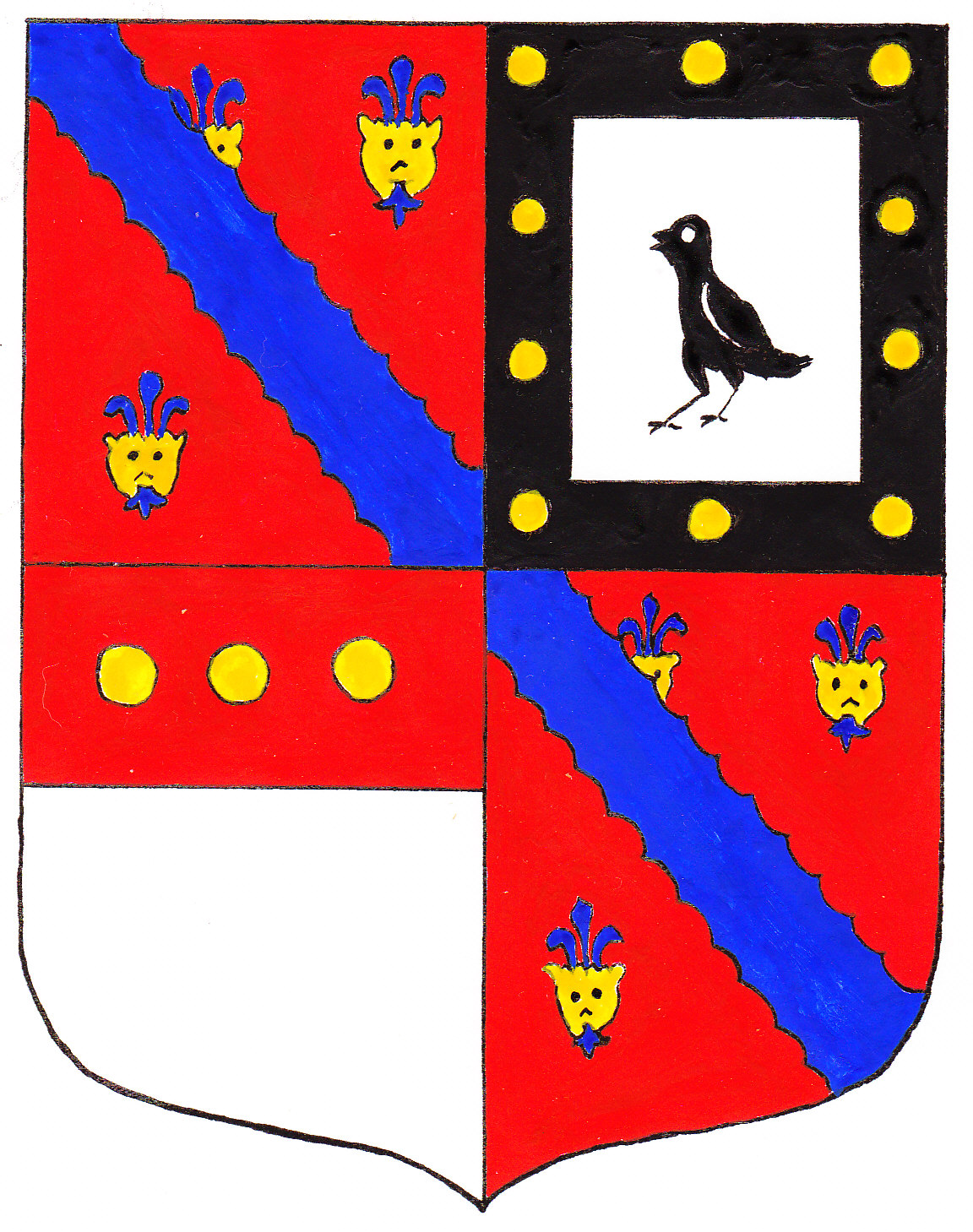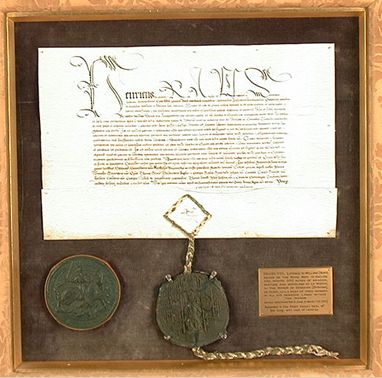|
Kington St. Michael Priory
St Mary's Priory was a Benedictine priory of nuns at Kington St Michael in Wiltshire, England. Founded before 1155, the priory was Dissolution of the Monasteries, dissolved in 1536. Parts of the priory buildings from the 13th and 15th centuries were incorporated into the present Priory Farm, where there is also modern rebuilding on old foundations. The last Prioress of Kington was Dame Marie Denys, a daughter of William Denys, Sir William Denys (1470–1533) of Dyrham Park, Dyrham, Gloucestershire and Lady Ann Berkeley, da. of Maurice, ''de jure'' 3rd Baron Berkeley (d.1506). She had previously been a nun at Lacock Abbey, and had just taken up her new appointment at the start of the Dissolution of the Monasteries. In the summer of 1535 the King's visitors came to Lacock and made a favourable report. John ap Rice wrote that he had "founde no notable compertes there" and commended the nuns of Lacock for their familiarity with their rule and constitutions. He informed Thomas Cromwel ... [...More Info...] [...Related Items...] OR: [Wikipedia] [Google] [Baidu] |
Kington Priory Ground Plan Brakspear 1923 33
{{disambig, geo ...
Kington may refer to: Places England * Kington, Herefordshire * Kington, historical name of Kineton, Warwickshire ** Kington Hundred * Kington, Worcestershire * Kington Magna, Dorset * Kington Langley, Wiltshire * Kington St Michael, Wiltshire * West Kington, Wiltshire People * Kington (surname) See also * Kingston (other) * Kinston (other) Kinston may refer to: *Kinston, Alabama *Kinston, North Carolina (Kingston until 1784) See also *Kingstone, Somerset *Kingston (other) *Kingston Bridge (other) *Kington (other) Kington may refer to: Places England * ... [...More Info...] [...Related Items...] OR: [Wikipedia] [Google] [Baidu] |
Benedictine
, image = Medalla San Benito.PNG , caption = Design on the obverse side of the Saint Benedict Medal , abbreviation = OSB , formation = , motto = (English: 'Pray and Work') , founder = Benedict of Nursia , founding_location = Subiaco Abbey , type = Catholic religious order , headquarters = Sant'Anselmo all'Aventino , num_members = 6,802 (3,419 priests) as of 2020 , leader_title = Abbot Primate , leader_name = Gregory Polan, OSB , main_organ = Benedictine Confederation , parent_organization = Catholic Church , website = The Benedictines, officially the Order of Saint Benedict ( la, Ordo Sancti Benedicti, abbreviated as OSB), are a monastic religious order of the Catholic Church following the Rule of Saint Benedict. They are also sometimes called the Black Monks, in reference to the colour of their religious habits. They ... [...More Info...] [...Related Items...] OR: [Wikipedia] [Google] [Baidu] |
Kington St Michael
Kington St Michael is a village and civil parish about north of Chippenham in Wiltshire, England. Location Kington St Michael is about west of the A350 which links Chippenham with junction 17 of the M4 motorway; the village is about southwest of the junction. It is largely a linear village based on its main street, which runs from southeast to northwest, where Honey Knob Hill leads into open countryside towards Grittleton. Easton Piercy, west of the village and now a farm and a few houses, was formerly a tithing of Kington St Michael, which had its own chapel in medieval times and a population of 41 in the 1840s. History A brief history of Kington St Michael is given in the relevant Wiltshire Community History page. There is evidence of habitation of the area in the New Stone Age and Bronze Ages. The first named settlement dates to about AD 934, when it was known as "Kington". Both Kington (''Chintone'') and Easton (''Estone'') were small settlements at the time of the 1 ... [...More Info...] [...Related Items...] OR: [Wikipedia] [Google] [Baidu] |
Wiltshire
Wiltshire (; abbreviated Wilts) is a historic and ceremonial county in South West England with an area of . It is landlocked and borders the counties of Dorset to the southwest, Somerset to the west, Hampshire to the southeast, Gloucestershire to the north, Oxfordshire to the northeast and Berkshire to the east. The county town was originally Wilton, after which the county is named, but Wiltshire Council is now based in the county town of Trowbridge. Within the county's boundary are two unitary authority areas, Wiltshire and Swindon, governed respectively by Wiltshire Council and Swindon Borough Council. Wiltshire is characterised by its high downland and wide valleys. Salisbury Plain is noted for being the location of the Stonehenge and Avebury stone circles (which together are a UNESCO Cultural and World Heritage site) and other ancient landmarks, and as a training area for the British Army. The city of Salisbury is notable for its medieval cathedral. Swindon is the ... [...More Info...] [...Related Items...] OR: [Wikipedia] [Google] [Baidu] |
William Denys
Sir William Denys (c. 1470–1533) of Dyrham, Gloucestershire, was a courtier of King Henry VIII and High Sheriff of Gloucestershire in 1518 and 1526. The surname is sometimes transcribed as Dennis. Origins He was the eldest son and heir of Sir Walter Denys (d. 1505) of Siston in Gloucestershire, by his 2nd wife Agnes Danvers, 2nd daughter & co-heiress of Sir Robert Danvers (died 1467) of Epwell, Oxfordshire, Chief Justice of the Common Pleas (1450–1467). The Inquisition ''post mortem'' of his father Sir Walter, dated 1505, states William his son and heir to have then been "aged 35 years and more", which suggests a date of birth of 1470. First marriage In about 1481 William's father arranged for him to marry Edith Twynyho, daughter of the wealthy Cirencester lawyer and cloth-merchant John Twynyho (1440–1485), whose monumental brass survives over his tomb in the south aisle of Lechlade Church, Glos. Twynyho served as MP for Bristol in 1472–1475 and again in 1484 and had b ... [...More Info...] [...Related Items...] OR: [Wikipedia] [Google] [Baidu] |
Dyrham Park
Dyrham Park () is a baroque English country house in an ancient deer park near the village of Dyrham in South Gloucestershire, England. The house, attached orangery, stable block, and accompanying parish church are Grade I listed buildings, while the park is Grade II* listed on the National Register of Historic Parks and Gardens. The current house was built for William Blathwayt in stages during the 17th and early 18th centuries on the site of a previous manor house, with the final facade being designed by William Talman. It contains art works and furniture from around the world, particularly Holland, and includes a collection of Dutch Masters. The house is linked to the 13th-century church of St Peter, where many of the Blathwayt family are buried. The house is surrounded by of formal gardens, and parkland which used to support a herd of fallow deer. The grounds, which were originally laid out by George London and later developed by Charles Harcourt Masters, include water f ... [...More Info...] [...Related Items...] OR: [Wikipedia] [Google] [Baidu] |
Baron Berkeley
The title Baron Berkeley originated as a feudal title and was subsequently created twice in the Peerage of England by writ. It was first granted by writ to Thomas de Berkeley, 1st Baron Berkeley (1245–1321), 6th feudal Baron Berkeley, in 1295, but the title of that creation became extinct at the death of his great-great-grandson, the fifth Baron by writ, when no male heirs to the barony by writ remained, although the feudal barony continued. The next creation by writ was in 1421, for the last baron's nephew and heir James Berkeley. His son and successor William was created Viscount Berkeley in 1481, Earl of Nottingham in 1483, and Marquess of Berkeley in 1488. He had no surviving male issue, so the Marquessate and his other non-inherited titles became extinct on his death in 1491, whilst the barony passed ''de jure'' to his younger brother Maurice. However William had disinherited Maurice because he considered him to have brought shame on the noble House of Berkeley by marryi ... [...More Info...] [...Related Items...] OR: [Wikipedia] [Google] [Baidu] |
Lacock Abbey
Lacock Abbey in the village of Lacock, Wiltshire, England, was founded in the early 13th century by Ela, Countess of Salisbury, as a nunnery of the Augustinian order. The abbey remained a nunnery until the suppression of Roman Catholic institutions in England in the 16th century; it was then sold to Sir William Sharington who converted the convent into a residence where he and his family lived. It was fortified and remained loyal to the crown during the English Civil War, but surrendered to the Parliamentary forces once Devizes had fallen in 1645. The house was built over the old cloisters and its main rooms are on the first floor. It is a stone house with stone slated roofs, twisted chimney stacks and mullioned windows. Throughout the life of the building, many architectural alterations, additions, and renovations have occurred so that the house is a mish-mash of different periods and styles. The Tudor stable courtyard to the north of the house has retained many of its ori ... [...More Info...] [...Related Items...] OR: [Wikipedia] [Google] [Baidu] |
Thomas Cromwell
Thomas Cromwell (; 1485 – 28 July 1540), briefly Earl of Essex, was an English lawyer and statesman who served as chief minister to King Henry VIII from 1534 to 1540, when he was beheaded on orders of the king, who later blamed false charges for the execution. Cromwell was one of the most powerful proponents of the English Reformation, and the creator of true English governance. He helped to engineer an annulment of the king's marriage to Catherine of Aragon so that Henry could lawfully marry Anne Boleyn. Henry failed to obtain the approval of Pope Clement VII for the annulment in 1533, so Parliament endorsed the king's claim to be Supreme Head of the Church of England, giving him the authority to annul his own marriage. Cromwell subsequently charted an evangelical and reformist course for the Church of England from the unique posts of Vicegerent in Spirituals and Vicar-general (the two titles refer to the same position). During his rise to power, Cromwell made many enemi ... [...More Info...] [...Related Items...] OR: [Wikipedia] [Google] [Baidu] |
Codrington, South Gloucestershire
Codrington is a settlement in South Gloucestershire, England. It is located near Junction 18 of the M4 motorway south of Wapley and Yate. Codrington is a hamlet situated alongside the B4465 road. It was formerly in the civil parish of Wapley-cum-Codrington in the hundred (county division), hundred of Grumbald's Ash. It is now in Dodington, Gloucestershire, Dodington parish, under the administration of the unitary authority of South Gloucestershire. It had one pub, the Wishing Well, which was formerly the Codrington Arms. The pub was linked to the Codrington Family, who used to be based at Codrington Court before moving to nearby Dodington Park. The area also has a Baptist church in Wapley Road. Now the area is best known for its golf course on the outskirts called The Players Club. The hamlet is mentioned in Lemon Jelly's "Ramblin' Man (Lemon Jelly song), Ramblin' Man". References External links Codrington Baptist Church Villages in South Gloucestershire District {{ ... [...More Info...] [...Related Items...] OR: [Wikipedia] [Google] [Baidu] |






